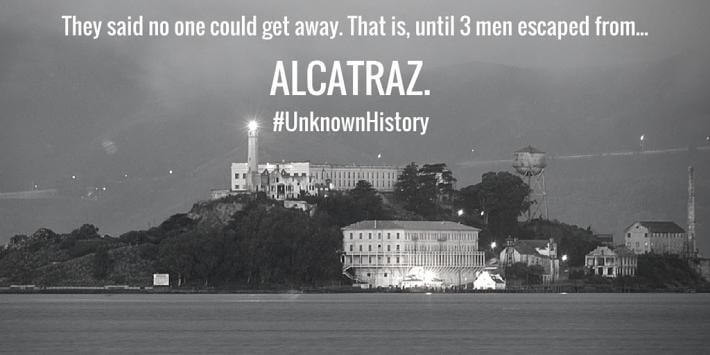How Did Three Men Escape from Alcatraz?
Many had tried, but none succeeded in escaping the high security prison. That is, until three criminals disappeared from their jail cells one summer evening. Hear the story, as excerpted from When Hitler Took Cocaine and Lenin Lost His Brain by Giles Milton, the basis for the podcast, Unknown History.
Giles Milton

Listen
How Did Three Men Escape from Alcatraz?
It was a routine inspection by the prison warders. On the morning of June 12th, 1962, the guards at Alcatraz high security prison made their morning check on the prisoners in their cells.
When they came to Cell Block B, they quickly realized that something was not quite right. The men were in their beds but they were showing no signs of life.
The guards unlocked the cells and were stunned by what they found. Frank Morris, John Anglin, and Clarence Anglin were missing; in their place were elaborately made paper-mâché heads with real hair and painted eyes. Three of Alcatraz’s most dangerous prisoners had escaped.
An Inescapable Fortress
Neither the guards nor the other prisoners could believe that they’d managed to get away. Alcatraz, after all, was one of the world’s most closely guarded prisons. Situated on a rocky island in San Francisco Bay, it was washed by cold and hazardous waters, making escape almost impossible.
In its twenty-nine years as a federal prison, from 1934 to 1963, no one had ever made it out alive. Forty-one inmates tried. Of those, twenty-six were recaptured, seven were shot dead and at least three were known to have drowned.
This proved no deterrent for the three new escapees. In fact, they saw the island’s isolation as a challenge.
The Runaways
All three men were hardened criminals. Frank Morris had been involved in a number of serious crimes ranging from armed robbery to dealing in narcotics. He had been transferred to Alcatraz in 1960.
John Anglin was also an infamous criminal. He’d robbed the Columbia Alabama Bank in 1958, together with his two brothers. It had earned him a thirty-five-year prison sentence.
Clarence Anglin had been involved in a number of other bank robberies and had also been caught escaping from the Atlanta State Penitentiary. It was decided to send him to Alcatraz, in order to prevent him from making any more escape attempts.
Their Plan
All of the men were highly resourceful and extremely motivated. They discovered that there was an unguarded three-foot-wide utility corridor behind their cells. This led to an air vent and thence to the outside world. The prisoners began to chisel away at the moisture-damaged concrete. For tools, they used metal spoons stolen from the canteen and an electric drill that they improvised from the motor of a stolen vacuum cleaner. They did most of the work during music hour, when the noise of accordions covered the sound of their hacking at the concrete.
They also made dummy heads from soap, toilet paper and real hair in order to fool the guards; there were constant checks on the prisoners throughout the night.
It took a year to tunnel through the wall of the service tunnel. The men then had to steal a long piece of cord in order to reach the manhole that covered the air vent. When they finally lifted the manhole cover, they replaced the metal bolts with fake ones made of soap. Finally, on the night of 11 June, all was ready. It was time to make their escape.
Everything went exactly to plan. They crawled into the utility corridor, climbed the air vent and reached the prison roof. Then they clambered down to the rocky ground and began pumping air into a raft that they’d previously made from rubber raincoats. They’d even managed to make oars.
The guards immediately began searching for the men, but did they ever find them?
To find out the answer, listen to the full episode of our new podcast, Unknown History, in the top right hand player of this page or on iTunes, Stitcher, and Spotify. Plus, connect with Giles on Twitter and Facebook.
This post is roughly excerpted from When Hitler Took Cocaine and Lenin Lost His Brain. You can purchase the book on Amazon, Barnes & Noble, Indiebound, Books-a-Million, and Apple.

